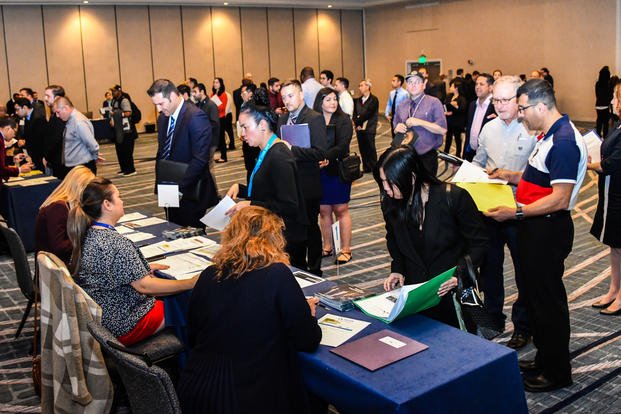The unemployment rate for all veterans fell to 7.9% in July from 8.6% in June, led by a drop of more than two percentage points in the jobless rate for post-9/11 veterans to 8.2%, the Bureau of Labor Statistics reported Friday.
The national unemployment rate also fell in July to 10.2% from 11.1 % in June in the "continued resumption of economic activity that had been curtailed due to the coronavirus pandemic and efforts to contain it," BLS said.
Read Next: Major Changes Coming for Marines’ Norway Deployments
The unemployment rate for all male veterans in July was 7.5%; for female vets, it was 10.7%, BLS added.
For post-9/11 veterans, classified as Gulf War II-era veterans by BLS, the unemployment rate was 8.2% in July, down from 10.3% in June
However, Gulf War I-era veterans, or those who served in the 1990s, saw their unemployment rate in July increase to 7.0% from 6.0% in June, BLS reported.
Despite new claims for unemployment continuing at a rate of more than one million for the past 20 weeks, the jobs market reflected "notable job gains" in leisure and hospitality businesses, government, retail trade, professional and business services, other services, and health care, BLS said.
Shortly after the BLS monthly jobs report was released, President Donald Trump tweeted: "Great jobs numbers!"
"We're happy to see the numbers get lower, [but] the reality is that we have a health crisis, not so much an economic crisis," said Thomas Porter, executive vice president of Iraq and Afghanistan Veterans of America. "We're not going to climb out of the economic hole we're in" until the pandemic is brought under control.
Bryan Rollins, director of the Warriors to Work program at the Wounded Warrior Project, agreed the numbers are encouraging but cautioned that "we haven't seen a huge change" in recent months in the number of job placements made through Wounded Warrior programs.
"We're roughly seeing about 35-40 job placements per week" since March, he said, adding that there has also been a shift to the service sector in types of jobs accepted.
To provide relief, IAVA and the WWP have joined with veterans service organizations in backing proposed legislation, H.R. 7111, approved by the House Veterans Affairs Committee last week.
The bill would grant up to 35,000 veterans who lost their jobs in COVID-19 layoffs an extra year of GI Bill benefits to retrain for high-skill jobs.
Lawmakers urged that the committee's bipartisan bill -- the Veterans Economic Recovery Act of 2020 -- be included in the next coronavirus relief package, although the House, Senate and White House are currently at an impasse over what the relief package will include.
In urging inclusion of the bill in the relief package, Rep. Phil Roe, R-Tenn., the ranking member of the House Veterans Affairs Committee, said in a statement, "Prior to the COVID-19 pandemic, we had the lowest veteran unemployment rate in 20 years.
"We owe it to our veterans to do everything we can do to get back there again," he said of the 3.6% unemployment rate for veterans recorded by BLS in February before the full impacts of the pandemic began to be felt.
One cautionary note to the July jobs report is that it was based on data collected through mid-July as COVID-19 cases and death tolls were rising across the nation, forcing states to impose more restrictions.
Federal Reserve Chairman Jerome Powell warned again last week that high unemployment rates will persist until the pandemic is brought under control.
"The pace of recovery looks like it has slowed" since the virus began to spike in June, he said at a July 29 news conference. "Recent labor market indicators point to a slowing in job growth, particularly among smaller businesses.
"There's probably going to be a long tail where a large number of people are struggling to get back to work," he added.
-- Richard Sisk can be reached at Richard.Sisk@Military.com.
Related: Veteran Unemployment Rate Drops in First Signs of Economic Rebound












